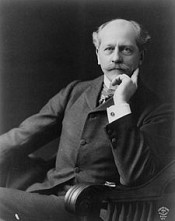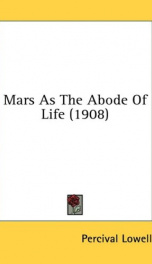Lowell Percival

Percival Lawrence Lowell (March 13, 1855–November 12, 1916) was a businessman, author, mathematician, and astronomer who fueled speculation that there were canals on Mars, founded the Lowell Observatory in Flagstaff, Arizona, and formed the beginning of the effort that led to the discovery of Pluto 14 years after his death. The choice of the name Pluto and its symbol were partly influenced by his initials PL. Percival Lowell, a descendant of the Boston Lowell family, was the brother of A. Lawrence, president of Harvard University, and Amy, an imagist poet, critic, and publisher.[1] Percival graduated from the Noble and Greenough School in 1872 and Harvard University in 1876 with distinction in mathematics.[1] At his college graduation, he gave a speech, considered very advanced for its time, on the "Nebular Hypothesis." He was later awarded honorary degrees from Amherst College and Clark University. [2] In the 1880s, Lowell traveled extensively in the Far East. In August 1883, he served as a foreign secretary and counsellor for a special Korean diplomatic mission to the United States. He also spent significant periods of time in Japan, writing books on Japanese religion, psychology, and behavior. His texts are filled with observations and academic discussions of various aspects of Japanese life, including language, religious practices, economics, travel in Japan, and the development of personality. Books by Percival Lowell on the Orient include Noto (1891) and Occult Japan (1894); the latter from his third and final trip to the region. The most popular of Lowell's books on the Orient, The Soul of the Far East, (1888) contains an early synthesis of some of his ideas, that in essence, postulated that human progress is a function of the qualities of individuality and imagination. Beginning in the winter of 1893-94, using his wealth and influence, Lowell dedicated himself to the study of astronomy, founding the observatory which bears his name.[3] For the last 23 years of his life astronomy, Lowell Observatory, and his and others' work at his observatory were the focal points of his life. He lived to be 61 years of age. World War I very much saddened Lowell, a dedicated pacifist. This, along with some setbacks in his astronomical work (described below), undermined his health and contributed to his death from a stroke on November 12, 1916.[4] Lowell is buried on Mars Hill near his observatory. Lowell became determined to study Mars and astronomy as a full-time career after reading Camille Flammarion's La planète Mars.[5] He was particularly interested in the canals of Mars, as drawn by Italian astronomer Giovanni Schiaparelli, who was director of the Milan Observatory. In 1894 Lowell chose Flagstaff, Arizona Territory as the home of his new observatory. At an altitude of over 2100 meters (7000 feet), with few cloudy nights, and far from city lights, Flagstaff was an excellent site for astronomical observations. This marked the first time an observatory had been deliberately located in a remote, elevated place for optimal seeing.[6] For the next fifteen years he studied Mars extensively, and made intricate drawings of the surface markings as he perceived them. Lowell published his views in three books: Mars (1895), Mars and Its Canals (1906), and Mars As the Abode of Life (1908). With these writings, Lowell more than anyone else popularized the long-held belief that these markings showed that Mars sustained intelligent life forms.[7] His works include a detailed description of what he termed the 'non-natural features' of the planet's surface, including especially a full account of the 'canals,' single and double; the 'oases,' as he termed the dark spots at their intersections; and the varying visibility of both, depending partly on the Martian seasons. He theorized that an advanced but desperate culture had built the canals to tap Mars' polar ice caps, the last source of water on an inexorably drying planet.[8] While this idea excited the public, the astronomical community was skeptical. Many astronomers could not see these markings, and few believed that they were as extensive as Lowell claimed. As a result, Lowell and his observatory were largely ostracized.[9] Although the consensus was that some actual features did exist which would account for these markings,[10] in 1909 the sixty-inch Mount Wilson Observatory telescope in Southern California allowed closer observation of the structures Lowell had interpreted as canals, and revealed irregular geological features, probably the result of natural erosion.[11] The existence of canal-like features would not be definitively disproved until Mariner 4 took the first close-up pictures of Mars in 1965, and Mariner 9 orbited and mapped the planet in 1972. Today, the surface markings taken to be canals are regarded as an optical illusion.[12] Although Lowell was better known for his observations of Mars, he also drew maps of the planet Venus. Lowell observed spoke-like features and a central dark spot, yet it is now known that Venus' atmosphere is opaque. In an article published in Sky and Telescope in July 2003, it was suggested that in fact Lowell was observing an image of the blood vessels in his own eye.[13] Lowell's greatest contribution to planetary studies came during the last decade of his life, which he devoted to the search for Planet X, a hypothetical planet beyond Neptune. Lowell believed that the planets Uranus and Neptune were displaced from their predicted positions by the gravity of the unseen Planet X.[14] Although Lowell's searches from 1905 to 1916 proved unsuccessful, the search continued after his death at Flagstaff in 1916.[15] In 1930, Clyde Tombaugh, a young astronomer recently hired by the Lowell Observatory, discovered the planet, named Pluto. Partly in recognition of Lowell's efforts, a stylized P-L monogram (the first two letters of the new planet's name and also Lowell's initials), was chosen as Pluto's astronomical symbol.[14] However, it would subsequently emerge that the Planet X theory was mistaken. Pluto's mass could not be determined until 1978, when a satellite was discovered. This confirmed what had been increasingly suspected: Pluto's gravitational influence on Uranus and Neptune is negligible, certainly not nearly enough to account for the discrepancies in their orbits.[16] In 2006, Pluto was reclassified as a dwarf planet by the International Astronomical Union. In addition, it is now known that the discrepancies between the predicted and observed positions of Uranus and Neptune were not caused by the gravity of an unknown planet. Rather, they were due to an erroneous value for the mass of Neptune. Voyager 2's 1989 encounter with Neptune yielded a more precise value of its mass, and the discrepancies disappear when using this value.[17] Although Lowell's theories of the Martian canals, of surface features on Venus, and of Planet X are now discredited, his practice of building observatories at the position where they would best function has been adopted as a principle.[14] He also established the program and setting which made the discovery of Pluto by Clyde Tombaugh possible.[18] Craters on the Moon and on Mars have been named after him.
do you like this author?
What readers are saying
What do you think? Write your own comment on this book!
write a commentWhat readers are saying
What do you think? Write your own comment on this author!
write a commentBook list

the solar system six lectures delivered at the massachusetts institute of techn
Series:
Unknown
Year:
Unknown
Raiting:
5/5
Show more
add to favoritesadd In favorites

occult japan or the way of the gods an esoteric study of japanese personality
Series:
Unknown
Year:
Unknown
Raiting:
4.5/5
1894. The manifestations of which this book treats were witnessed by the writer in 1891 and 1893. Since then the miracles, he learns, have become one of the sights that visitors are taken to see, and on the 15th of April and of September the grounds of his friend, the high priest at Kanda, show many a tourist from the other side of the world amid the devout crowds about the sacred bed of coals. The illustrations are from photographs by the writer, taken at the time. Contents: Ontake; Shinto; Miracles; Incarnations; Pilgrimages and the Pilgrim Clubs; Gohei; Shrines of Ise; Noumena: Self; Selfhood; Possession; Will; Self as Ideas; Ideas a Mode of Motion; Ideas a Force; Individuality; Japanese Character; Dreams; Hypnotic and Possession Trances; Shinto Gods.
Show more
add to favoritesadd In favorites
Book list

the solar system six lectures delivered at the massachusetts institute of techn
Series:
Unknown
Year:
Unknown
Raiting:
5/5
Show more
add to favoritesadd In favorites

occult japan or the way of the gods an esoteric study of japanese personality
Series:
Unknown
Year:
Unknown
Raiting:
4.5/5
1894. The manifestations of which this book treats were witnessed by the writer in 1891 and 1893. Since then the miracles, he learns, have become one of the sights that visitors are taken to see, and on the 15th of April and of September the grounds of his friend, the high priest at Kanda, show many a tourist from the other side of the world amid the devout crowds about the sacred bed of coals. The illustrations are from photographs by the writer, taken at the time. Contents: Ontake; Shinto; Miracles; Incarnations; Pilgrimages and the Pilgrim Clubs; Gohei; Shrines of Ise; Noumena: Self; Selfhood; Possession; Will; Self as Ideas; Ideas a Mode of Motion; Ideas a Force; Individuality; Japanese Character; Dreams; Hypnotic and Possession Trances; Shinto Gods.
Show more
add to favoritesadd In favorites

occult japan or the way of the gods an esoteric study of japanese personalit
Series:
Unknown
Year:
Unknown
Raiting:
4.5/5
Show more
add to favoritesadd In favorites

occult japan or the way of the gods an esoteric study of japanese personali
Series:
Unknown
Year:
Unknown
Raiting:
4/5
Show more
add to favoritesadd In favorites

mars as the abode of life
Series:
Unknown
Year:
Unknown
Raiting:
3/5
This Elibron Classics book is a facsimile reprint of a 1909 edition by the Macmillan Company, New York. --This text refers to the Paperback edition.
Show more
add to favoritesadd In favorites

mars and its canals
Series:
Unknown
Year:
Unknown
Raiting:
5/5
Purchase of this book includes free trial access to www.million-books.com where you can read more than a million books for free. This is an OCR edition with typos. Excerpt from book: MARS AND ITS CANALS CHAPTER I ON EXPLORATION ROM time immemorial travel and discovery have called with strange insistence to him who, wondering on the world, felt adventure in his veins. The leaving familiar sights and faces to push forth into the unknown has with magnetic force drawn the bold to great endeavor and fired the thought of those who stayed at home. Spur to enterprise since man first was, this spirit has urged him over the habitable globe. Linked in part to mere matter of support it led the more daring of the Aryans to quit the shade of their beech trees, reposeful as that umbrage may have been, and wander into Central Asia, so to perplex philologists into believing them to have originated there; it lured Columbus across the waste of waters and caused his son to have carved upon his tomb that ringing couplet of which the simple grandeur still stirs the blood: A Oastilla Y A Leon Xukvo Moxdo nio Colon; (To Castile and Leon beyond the wave Another world Columbus gave;) it drove the early voyagers into the heart of the vast wilderness, there to endure all hardship so that they might come where their kind had never stood before; and now it points man to the pole. Something of the selfsame spirit finds a farther field today outside the confines of our traversable earth. Science which has caused the world to shrink and dwindle has been no less busy bringing near what in the past seemed inaccessibly remote. Beyond our earth man's penetration has found it possible to pierce, and in its widening circle of research has latterly been made aware of another world of strange enticement across the depths of space. Planetary distances, not mundane ones, are here concerned, and the globe to be explored, though akin to, is yet very different from, our own. This ...
Show more
add to favoritesadd In favorites

Noto: an Unexplained Corner of Japan
Series:
Unknown
Year:
Unknown
Raiting:
3/5
Percival Lawrence Lowell (1855-1916) was a businessman, author, mathematician, and astronomer who fueled speculation that there were canals on Mars, founded the Lowell Observatory and formed the beginning of the effort that led to the discovery of Pluto 14 years after his death. Percival graduated from Harvard University in 1876 with distinction in mathematics. In 1883, he served as a foreign secretary and counsellor for a special Korean diplomatic mission to the United States. He also spent significant periods of time in Japan, writing books on Japanese religion, psychology, and behavior. His texts are filled with observations and academic discussions of various aspects of Japanese life. Books by Percival Lowell on the Orient include Noto: An Unexplained Corner of Japan (1891) and Occult Japan (1894). The most popular of Lowell's books on the Orient, The Soul of the Far East (1888) contains an early synthesis of some of his ideas, that in essence, postulated that human progress is a function of the qualities of individuality and imagination. Amongst his other books are Mars (1895) and The Genesis of the Planets (1916). --This text refers to the Paperback edition.
Show more
add to favoritesadd In favorites
What readers are saying
What do you think? Write your own comment on this author!
write a commentif you like Lowell Percival try:
readers also enjoyed
What readers are saying
What do you think? Write your own comment on this author!
write a commentGenre
if you like Lowell Percival try:
readers also enjoyed
Do you want to read a book that interests you? It’s EASY!
Create an account and send a request for reading to other users on the Webpage of the book!


